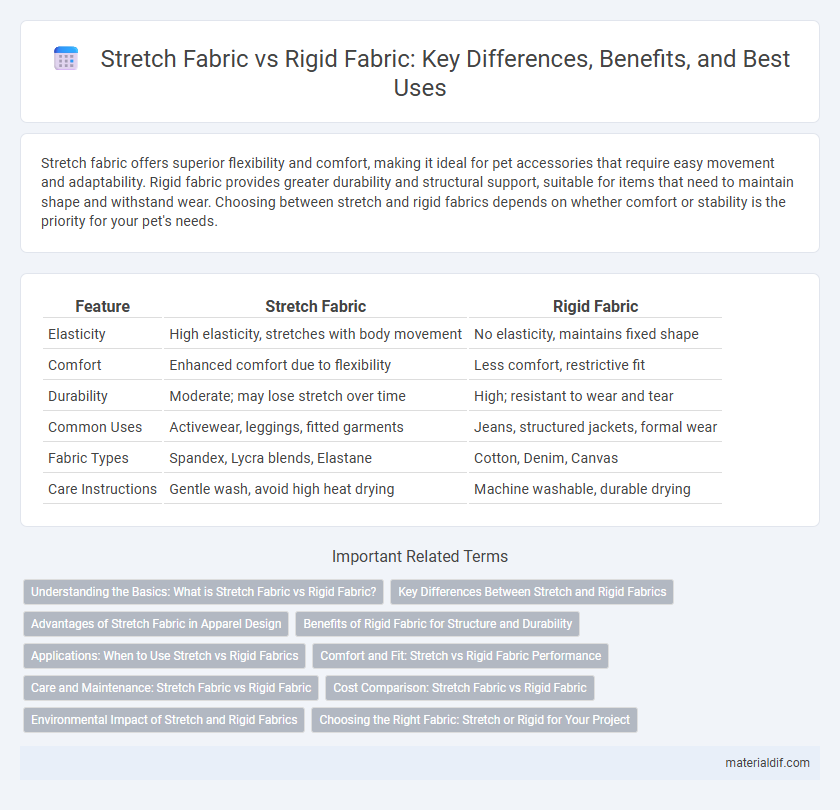Stretch fabric offers superior flexibility and comfort, making it ideal for pet accessories that require easy movement and adaptability. Rigid fabric provides greater durability and structural support, suitable for items that need to maintain shape and withstand wear. Choosing between stretch and rigid fabrics depends on whether comfort or stability is the priority for your pet's needs.
Table of Comparison
| Feature | Stretch Fabric | Rigid Fabric |
|---|---|---|
| Elasticity | High elasticity, stretches with body movement | No elasticity, maintains fixed shape |
| Comfort | Enhanced comfort due to flexibility | Less comfort, restrictive fit |
| Durability | Moderate; may lose stretch over time | High; resistant to wear and tear |
| Common Uses | Activewear, leggings, fitted garments | Jeans, structured jackets, formal wear |
| Fabric Types | Spandex, Lycra blends, Elastane | Cotton, Denim, Canvas |
| Care Instructions | Gentle wash, avoid high heat drying | Machine washable, durable drying |
Understanding the Basics: What is Stretch Fabric vs Rigid Fabric?
Stretch fabric contains elastic fibers such as spandex or Lycra, enabling it to expand and return to its original shape, making it ideal for activewear and fitted garments. Rigid fabric lacks elasticity, offering a stable structure that is commonly used in denim, cotton, and woven fabrics for durability and a defined silhouette. Understanding the fiber composition and intended use is crucial for selecting the appropriate fabric type in fashion and upholstery applications.
Key Differences Between Stretch and Rigid Fabrics
Stretch fabrics contain elastane or spandex fibers, providing high elasticity that allows the material to recover its shape after being stretched, ideal for activewear and form-fitting garments. Rigid fabrics, typically made from cotton, linen, or polyester without elastic fibers, offer limited stretch and maintain a structured, stable form, making them suitable for tailored clothing and upholstery. The primary difference lies in flexibility and recovery, with stretch fabrics offering greater comfort and movement, while rigid fabrics prioritize durability and shape retention.
Advantages of Stretch Fabric in Apparel Design
Stretch fabric enhances apparel design by providing superior comfort and ease of movement, making garments more wearable for active lifestyles. Its elasticity allows for a better fit, contouring to various body shapes and reducing the need for precise sizing. Additionally, stretch fabrics improve garment durability by recovering shape after wear, reducing sagging and bagging over time.
Benefits of Rigid Fabric for Structure and Durability
Rigid fabric provides superior structural support and long-lasting durability, making it ideal for applications requiring shape retention and strength. Its resistance to stretching ensures consistent performance in products like upholstery, outdoor gear, and industrial materials. The enhanced stability of rigid fabric helps maintain form under stress, reducing wear and extending the lifespan of the finished item.
Applications: When to Use Stretch vs Rigid Fabrics
Stretch fabrics excel in applications requiring flexibility and comfort such as activewear, swimwear, and fitted garments, providing enhanced mobility and a snug fit. Rigid fabrics are ideal for structured clothing like suits, jackets, and denim, where shape retention and durability are essential. Choosing stretch or rigid fabric depends on the desired garment functionality, movement allowance, and aesthetic requirements.
Comfort and Fit: Stretch vs Rigid Fabric Performance
Stretch fabric offers superior comfort by allowing greater flexibility and movement, conforming closely to body contours for a tailored fit. Rigid fabric provides structured support but may restrict motion and feel less adaptable during extended wear. The performance of stretch fabric enhances fit and comfort, making it ideal for activewear and garments requiring dynamic movement.
Care and Maintenance: Stretch Fabric vs Rigid Fabric
Stretch fabric requires gentle washing in cold water and air drying to maintain elasticity and prevent damage, while rigid fabric can typically withstand higher temperatures and machine drying without losing shape. Avoiding bleach and harsh detergents is crucial for both, but stretch fabrics are more prone to pilling and snags, necessitating delicate handling. Proper storage, such as folding stretch fabrics flat and hanging rigid fabrics, helps preserve their structural integrity and longevity.
Cost Comparison: Stretch Fabric vs Rigid Fabric
Stretch fabric generally costs more than rigid fabric due to the incorporation of elastic fibers such as spandex or Lycra, which increase production expenses. Rigid fabrics, composed primarily of non-stretch fibers like cotton or polyester without elastane, tend to have lower manufacturing costs and are often more budget-friendly. When considering durability and application, the higher cost of stretch fabric can be justified by enhanced comfort and flexibility, making it a cost-effective choice for performance or activewear.
Environmental Impact of Stretch and Rigid Fabrics
Stretch fabrics, often made from synthetic fibers like spandex or elastane, have a higher environmental impact due to their reliance on petrochemicals and difficulty in recycling. Rigid fabrics, typically woven from natural fibers such as cotton or linen, tend to be more biodegradable and sustainable when sourced responsibly. The production of stretch fabrics also involves energy-intensive processes and releases microplastics, contributing to pollution and environmental degradation.
Choosing the Right Fabric: Stretch or Rigid for Your Project
Choosing between stretch fabric and rigid fabric depends on the project's requirements for flexibility and structure. Stretch fabrics, composed of materials like spandex or elastane, provide elasticity and comfort, making them ideal for activewear and fitted garments. Rigid fabrics, such as denim or canvas, offer durability and shape retention, suitable for structured apparel and home decor.
Stretch Fabric vs Rigid Fabric Infographic

 materialdif.com
materialdif.com